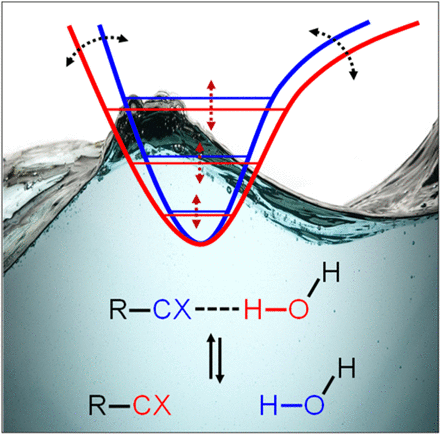当前位置:
X-MOL 学术
›
Chem. Rev.
›
论文详情
Our official English website, www.x-mol.net, welcomes your
feedback! (Note: you will need to create a separate account there.)
Vibrational Spectroscopic Map, Vibrational Spectroscopy, and Intermolecular Interaction.
Chemical Reviews ( IF 51.4 ) Pub Date : 2020-06-29 , DOI: 10.1021/acs.chemrev.9b00813 Carlos R Baiz 1 , Bartosz Błasiak 2 , Jens Bredenbeck 3 , Minhaeng Cho 4, 5 , Jun-Ho Choi 6 , Steven A Corcelli 7 , Arend G Dijkstra 8 , Chi-Jui Feng 9 , Sean Garrett-Roe 10 , Nien-Hui Ge 11 , Magnus W D Hanson-Heine 12 , Jonathan D Hirst 12 , Thomas L C Jansen 13 , Kijeong Kwac 4 , Kevin J Kubarych 14 , Casey H Londergan 15 , Hiroaki Maekawa 11 , Mike Reppert 16 , Shinji Saito 17 , Santanu Roy 18 , James L Skinner 19 , Gerhard Stock 20 , John E Straub 21 , Megan C Thielges 22 , Keisuke Tominaga 23 , Andrei Tokmakoff 9 , Hajime Torii 24 , Lu Wang 25 , Lauren J Webb 26 , Martin T Zanni 27
Chemical Reviews ( IF 51.4 ) Pub Date : 2020-06-29 , DOI: 10.1021/acs.chemrev.9b00813 Carlos R Baiz 1 , Bartosz Błasiak 2 , Jens Bredenbeck 3 , Minhaeng Cho 4, 5 , Jun-Ho Choi 6 , Steven A Corcelli 7 , Arend G Dijkstra 8 , Chi-Jui Feng 9 , Sean Garrett-Roe 10 , Nien-Hui Ge 11 , Magnus W D Hanson-Heine 12 , Jonathan D Hirst 12 , Thomas L C Jansen 13 , Kijeong Kwac 4 , Kevin J Kubarych 14 , Casey H Londergan 15 , Hiroaki Maekawa 11 , Mike Reppert 16 , Shinji Saito 17 , Santanu Roy 18 , James L Skinner 19 , Gerhard Stock 20 , John E Straub 21 , Megan C Thielges 22 , Keisuke Tominaga 23 , Andrei Tokmakoff 9 , Hajime Torii 24 , Lu Wang 25 , Lauren J Webb 26 , Martin T Zanni 27
Affiliation

|
Vibrational spectroscopy is an essential tool in chemical analyses, biological assays, and studies of functional materials. Over the past decade, various coherent nonlinear vibrational spectroscopic techniques have been developed and enabled researchers to study time-correlations of the fluctuating frequencies that are directly related to solute–solvent dynamics, dynamical changes in molecular conformations and local electrostatic environments, chemical and biochemical reactions, protein structural dynamics and functions, characteristic processes of functional materials, and so on. In order to gain incisive and quantitative information on the local electrostatic environment, molecular conformation, protein structure and interprotein contacts, ligand binding kinetics, and electric and optical properties of functional materials, a variety of vibrational probes have been developed and site-specifically incorporated into molecular, biological, and material systems for time-resolved vibrational spectroscopic investigation. However, still, an all-encompassing theory that describes the vibrational solvatochromism, electrochromism, and dynamic fluctuation of vibrational frequencies has not been completely established mainly due to the intrinsic complexity of intermolecular interactions in condensed phases. In particular, the amount of data obtained from the linear and nonlinear vibrational spectroscopic experiments has been rapidly increasing, but the lack of a quantitative method to interpret these measurements has been one major obstacle in broadening the applications of these methods. Among various theoretical models, one of the most successful approaches is a semiempirical model generally referred to as the vibrational spectroscopic map that is based on a rigorous theory of intermolecular interactions. Recently, genetic algorithm, neural network, and machine learning approaches have been applied to the development of vibrational solvatochromism theory. In this review, we provide comprehensive descriptions of the theoretical foundation and various examples showing its extraordinary successes in the interpretations of experimental observations. In addition, a brief introduction to a newly created repository Web site (http://frequencymap.org) for vibrational spectroscopic maps is presented. We anticipate that a combination of the vibrational frequency map approach and state-of-the-art multidimensional vibrational spectroscopy will be one of the most fruitful ways to study the structure and dynamics of chemical, biological, and functional molecular systems in the future.
中文翻译:

振动光谱图、振动光谱和分子间相互作用。
振动光谱是化学分析、生物测定和功能材料研究的重要工具。在过去的十年中,各种相干非线性振动光谱技术得到了发展,使研究人员能够研究与溶质-溶剂动力学、分子构象动态变化和局部静电环境、化学和生化反应直接相关的波动频率的时间相关性、蛋白质结构动力学与功能、功能材料的特征过程等。为了获得有关功能材料的局部静电环境、分子构象、蛋白质结构和蛋白质间接触、配体结合动力学以及电学和光学性质的深入和定量信息,已经开发了多种振动探针并将其位点特异性地纳入用于时间分辨振动光谱研究的分子、生物和材料系统。然而,由于凝聚相分子间相互作用的内在复杂性,描述振动溶剂化变色、电致变色和振动频率动态涨落的包罗万象的理论尚未完全建立。特别是,从线性和非线性振动光谱实验获得的数据量一直在迅速增加,但缺乏定量方法来解释这些测量结果一直是扩大这些方法应用的一个主要障碍。 在各种理论模型中,最成功的方法之一是半经验模型,通常称为振动光谱图,它基于严格的分子间相互作用理论。最近,遗传算法、神经网络和机器学习方法已应用于振动溶剂化变色理论的发展。在这篇综述中,我们对理论基础进行了全面的描述,并提供了各种例子,展示了其在解释实验观察方面取得的非凡成功。此外,还简要介绍了新创建的振动光谱图存储库网站 (http://Frequencymap.org)。我们预计,振动频率图方法和最先进的多维振动光谱学的结合将成为未来研究化学、生物和功能分子系统的结构和动力学最富有成效的方法之一。
更新日期:2020-08-12
中文翻译:

振动光谱图、振动光谱和分子间相互作用。
振动光谱是化学分析、生物测定和功能材料研究的重要工具。在过去的十年中,各种相干非线性振动光谱技术得到了发展,使研究人员能够研究与溶质-溶剂动力学、分子构象动态变化和局部静电环境、化学和生化反应直接相关的波动频率的时间相关性、蛋白质结构动力学与功能、功能材料的特征过程等。为了获得有关功能材料的局部静电环境、分子构象、蛋白质结构和蛋白质间接触、配体结合动力学以及电学和光学性质的深入和定量信息,已经开发了多种振动探针并将其位点特异性地纳入用于时间分辨振动光谱研究的分子、生物和材料系统。然而,由于凝聚相分子间相互作用的内在复杂性,描述振动溶剂化变色、电致变色和振动频率动态涨落的包罗万象的理论尚未完全建立。特别是,从线性和非线性振动光谱实验获得的数据量一直在迅速增加,但缺乏定量方法来解释这些测量结果一直是扩大这些方法应用的一个主要障碍。 在各种理论模型中,最成功的方法之一是半经验模型,通常称为振动光谱图,它基于严格的分子间相互作用理论。最近,遗传算法、神经网络和机器学习方法已应用于振动溶剂化变色理论的发展。在这篇综述中,我们对理论基础进行了全面的描述,并提供了各种例子,展示了其在解释实验观察方面取得的非凡成功。此外,还简要介绍了新创建的振动光谱图存储库网站 (http://Frequencymap.org)。我们预计,振动频率图方法和最先进的多维振动光谱学的结合将成为未来研究化学、生物和功能分子系统的结构和动力学最富有成效的方法之一。











































 京公网安备 11010802027423号
京公网安备 11010802027423号